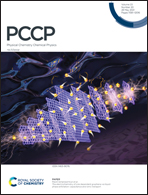First-principles study of the optical and thermoelectric properties of tetragonal-silicene†
Abstract
We report the optical and thermoelectric properties of the two-dimensional Dirac material T-silicene (TS) sheet and nanoribbons (NRs) by first-principles calculations. Both the optical and thermoelectric properties of TS can be modified by tailoring the sheet into nanoribbons of different widths and edge geometries. The optical response of the structures is highly anisotropic. A π interband transition occurs in the visible range of incident light with parallel polarization. The optical response for asymmetric arm-chair TS nanoribbons (ATSNRs) is larger than for symmetric ATSNRs. The absorptions of asymmetric ATSNR are redshifted due to a decrease in the bandgap with the width of the NRs. Plasma frequencies of the sheet and the NRs are identified from the imaginary part of the dielectric function and electron energy loss spectra curves. Thermoelectric properties like electrical conductivity, Seebeck coefficient, power factor, and electronic figure of merit are also studied. Compared with graphene, the TS sheet possesses a higher electrical conductivity and a better figure of merit. Among the NRs, asymmetric ATSNRs exhibit a better thermoelectric performance. All these intriguing features of TS may shed light on fabricating smart opto-electronic and thermoelectric devices.



 Please wait while we load your content...
Please wait while we load your content...